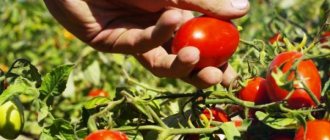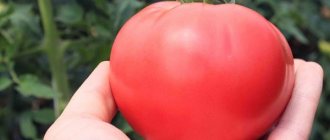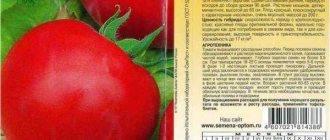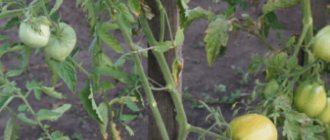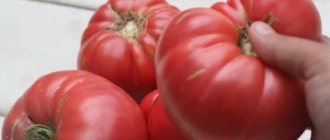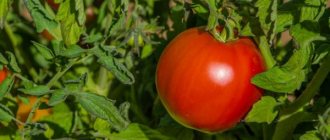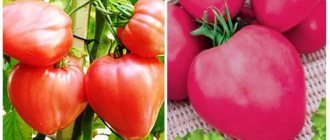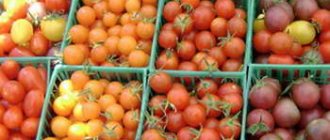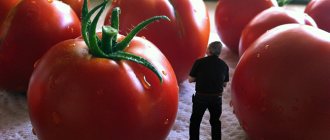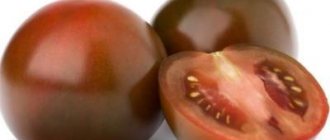Tomato Main caliber F1 is a large fruit with very tasty and tender pulp. They have a sugary consistency and can be broken by hand without using a knife. This salad hybrid is appreciated by many tomato lovers.
| Height | Landing location | Ripening time | Fruit color | Fruit size | Origin | Fruit shape |
| Medium height | Greenhouse, Open ground | Mid-season | Pink | Large | Hybrid | Flat-round |
Features of planting and growing tomato Hali-gali
From the point of view of agricultural technology, the Hali-gali tomato is of no interest to those who like experimenting: all operations for planting and caring for the plant are carried out in a completely traditional way. Remembering that this is a hybrid, you have to come to terms with the fact that it is pointless to collect seeds from your own harvest; you have to buy them. In the southern regions, given the early ripeness of the hybrid, it is possible to sow seeds directly into the garden bed with the onset of warm weather (late April or early May); in other areas, seedlings are grown by sowing seeds in pots or boxes in the second half of March.
Video: Hali-gali tomato seeds
Growing seedlings occurs in the usual way: be sure to reduce the temperature immediately after germination, and after 4-5 days return it to normal values: a little above 20 oC during the day and a little lower at night. It is preferable not to avoid picking seedlings at 10–12 days of age: tomatoes love this operation because it causes the growth of the root system. Water the seedlings moderately; they prefer to do without fertilizing: if the soil is nutritious, it is better to keep the seedlings on a half-starved ration so that they get used to difficulties. A week before planting in the garden, the seedlings must be hardened off.
Hali-gali seedlings are planted in heated soil relatively densely, according to a pattern of 40 x 50 cm. Despite their determinacy, the plants require support: without a garter, bushes with fruits quickly fall to the ground. Forming a bush is not difficult, but regular removal of excess shoots is mandatory. It is best to grow a bush with two or three stems. During flowering, the bushes are periodically slightly shaken to improve the fertilization of flowers.
For determinate varieties, there are different schemes for the formation of bushes
The watering regime, despite the drought resistance of the hybrid, is normal: in the first half of summer they try to keep the soil in a moderately moist state; after the fruits begin to turn red, watering is stopped. Loosening the soil and removing weeds is mandatory. The Hali-gali tomato requires fertilizing, regardless of the degree of soil fertility. The plants are fed the first time two weeks after planting the seedlings, the second time at the very beginning of flowering, then every two weeks. The first two feedings are carried out with complex fertilizer, then nitrogen is eliminated.
The Hali-gali tomato is so resistant to diseases that even preventive spraying is not carried out on personal plots. Dangerous pests include thrips, aphids and the Colorado potato beetle; in most cases, they can be controlled with folk remedies; if the number of pests is high, it is permissible to use insecticides long before harvest.
Tomatoes main size description - Summer resident's guide
“Main Caliber” tomatoes are large-caliber tomatoes.
The seeds were ordered through the online store according to the catalog “Gardens of Russia, spring 2015”. Sowing seeds in our region has to be done in a greenhouse. I sowed tomatoes in a greenhouse on 03/28/15. 02/05 tomato seedlings were planted in a nursery. And only on June 5, my daughter and I planted well-grown seedlings in the ground and immediately tied them up.
And the flowers are a miracle!
The entry is posted in the sections: my favorite tomato, personal experience of readers
Amazing tomatoes | sotki.ru | Your 6 acres
Having been involved in vegetable growing for many years, you often find yourself on the verge of disappointment. Can anything else be surprising? Maybe!
But these doubts disappear when contemplating the beauty, power, grace and taste of new tomato varieties. More than a thousand of them have been tested, but the current successes of world selection are amazing.
Last year's weather conditions were favorable for tomatoes; I was able to test 51 new varieties and 33 hybrids, 18 of them new. At the same time, he received a record harvest of 240 kg.
First, a little about hybrids. Just a few years ago they could not be distinguished from one another, like twin brothers: all round and red.
Now, thanks to the efforts of breeders, their shapes have become very diverse: the pepper-shaped F1 Cornabel, the ribbed-flat F1 Rebelion, with a spout, like its literary prototype, F1 Cyrano.
What about the colors? Dark chocolate F1 Ashdod, orange plum F1 Organza, yellow portioned F1 Gualdino. I’m not even talking about pink fruits with their sweet taste.
The best yield was shown by: F1 Diamantino (5.8 kg per plant),
F1 Geronimo (5.6 kg), F1 Velasco (5.6 kg), F1 Gualdino (4.6 kg), F1 Attia (4.4 kg), F1 Red Buffalo (4.4 kg), F1 Sir Elian ( 4.3 kg), F1 Organza (4.2 kg).
I would especially like to highlight the leader of last season – the F1 Silhouette hybrid. This year it was planted in one of the worst places in the greenhouse, but despite this, it showed excellent results (5.3 kg), which indicates its highest plasticity.
The largest fruits were noted for the hybrid F1 Orange Barrel, which pleased two giants with more than 1 kg per plant without any shaping.
Pink tomatoes always have a sweet taste and tender flesh. The large-fruited varieties Pandarosa Henderson with high yield (4.2 kg) and Mister Hart pink were no exception.
An elegant plant of the Pink Heart variety is all hung with delicate fruits; 4.2 kg were collected from one bush. The unusual variety Pink Hairy Boar is distinguished by its pubescent fruits.
And the incomparable variety Purple Brandy really has such a strange name for a pink tomato, inherited from its parents.
The largest group is represented by black-fruited tomatoes. This is not surprising. Abroad, they have long understood the undoubted health benefits of the pigments included in their composition. And plus a wonderful taste.
What else do you need? Among the new products, I would like to note: the incomparably harmonious varieties 1884 purple and Cherokee purple heart, which have no equal in taste, as well as the varieties Black Master, Chocolate Amazon, Black and Burgundy, Kumato, Black Early, D.B.
Cooper, Black and Blue Ridge, Swart, Black Sweetie. A choice for every taste!
We were also pleased with the new yellow-fruited varieties: the large-fruited variety Martha Logan, the amazingly beautiful variety Prelest Rose with huge (up to 900 g) fruits and the Golden Canary with fancy (with a spout) fruits collected in clusters of up to 30 pieces.
Unusual yellow-orange and red fruits from newcomers to the Russian garden - varieties German Old and E.T. They are large, weighing up to 600–700 g, beautiful, with a delicate taste. Just a miracle!
The variety of colors of your plot will be enriched by unique new products: a determinate variety with elongated green fruits, Sausage Green, a variety with white fruits covered with streaks, White Zebra, unusual varieties with dark blue fruits, Blue Oxness and Blue Chocolate.
The beauty of the form will satisfy the tastes of any esthete. Here are the heart-shaped fruits of the varieties Working Paste Release (the unusual name is closely intertwined with the delicious taste), Early Love (huge, delicious fruits ripen first), Cherokee Purple Heart (incomparable taste), Pink Heart and Russian Orange.
The varieties Gianini, Egyptian, Italian spaghetti, and Auria are distinguished by their elongated fruits.
Fans of large forms will not be left indifferent by Claude Brown's Giant and Herman the Giant with fruits weighing up to 1 kg.
There are also new products for obtaining a super early harvest. These are the varieties Jurmala (3.8 kg) and Original (5.3 kg). They are tall, completely covered with large fruits (300–600 g) of excellent taste. And the entire harvest is given in July - August. For gardeners in the northern regions, this is simply a godsend!
Characteristics and description of the Snow White tomato
The tomato variety with the beautiful name “Snow White” is loved by gardeners for its unpretentiousness and a number of positive qualities. It is not afraid of bad weather, the bushes do not require staking due to their compactness, and the fruits ripen early.
Small tomatoes are convenient both for canning and for preparing salads.
Characteristics and properties
The Snow White tomato is mainly grown in Russia, Ukraine and Moldova. Due to its resistance to cold and heat, tomatoes can be grown in open ground anywhere. The height of the bushes ranges from 45 to 50 centimeters, and in general the plant is very compact: it has a small number of leaves and therefore does not need tying up. The variety of this tomato is an early ripening variety, and the first harvest can be obtained approximately 85-95 days after planting in the ground.
The shape of the ripened fruit is smooth and round, and the weight is about 90 - 120 grams. The Snow White tomato has a bright red color, despite its interesting name. A very meaty, tasty and aromatic tomato. The tomato has a universal table value and is used both for preparing twists and for creating salads. In addition, fresh fruits do not crack and are well stored and transported.
The yield per bush is around two to three kilograms. Thanks to the early ripening and uniform ripening of fruits, “Snow White” most often avoids diseases. This cold- and heat-resistant variety is capable of producing crops in any weather: it does not care about temperature changes. The only exception is long-term frosts.
Advantages and disadvantages
The advantages of the Snow White variety are:
- cold and heat resistance;
- rapid ripening of tomatoes;
- excellent taste and aroma;
- long-term storage of tomatoes;
- the fruits do not crack;
- bushes do not need tying;
- the crop ripens evenly;
- resistance to late blight;
- universal use of ripened tomatoes;
- interesting name.
Among the disadvantages of this tomato variety it is worth noting:
Care and breeding
Seeds for seedlings are planted in well-ventilated soil to a depth of approximately one to one and a half centimeters. It is approximately better to do this in March. Seedlings should be fed 2-3 times with mineral fertilizers. Seedlings are planted in open ground at the age of 50 - 55 days. If it is cold outside, then it is better to make a shelter for the young seedlings, and then the variety will be hardened and will not be afraid of bad weather. The planting pattern should be 40 x 40.
Tomatoes should be watered with warm water two to three times a week, but not overwatered. The Snow White variety requires periodic loosening of the soil and removal of weeds. There is no need to plant bushes of this type: it can even harm the plant. Tomato responds well to fertilizing, both organic - humus, mullein, droppings, and purchased fertilizers. Since tomatoes and bushes are small in size, there is no need for tying. Due to its rapid ripening, the Snow White variety is not susceptible to late blight, but parasites can have a detrimental effect. Therefore, it is recommended to treat plants with products against garden pests.
Low-growing tomatoes of the Urals
Early ripening Gnome is a universal determinant, the height of which does not exceed 45–50 cm. And the fruits of this variety are medium-sized—45–60 g, with a yield of about 3.5–4 kg/m2. But the cultivar is not afraid of macrosporiosis and is characterized by high fruit set. The gnome is suitable for drying and fresh snacks, and its thick skin allows you to prepare tomatoes in slices in a marinade.
The gnome is moderately susceptible to late blight and almost does not crack
Demidov is a variety of Siberian selection, does not require support or garter, but is not inferior in yield to vigorous-growing ones - more than 4-6 kg/m2. The determinate bush reaches no more than 0.6 m; by the end of July, the ground cultivar is strewn with pinkish-carmine fruits, 100–120 g each, which are especially good fresh. Fruits can be ripened, and fully ripe fruits can be stored for more than a month; tomato is not afraid of sudden cold snaps. This is a water-growing variety; without periodic watering, the yield begins to fall. It should also be remembered that with a lack of moisture, Demidov fruits are affected by blossom end rot.
The determinate standard tomato Watercolor grows no higher than 40–45 cm. Red-sided with a greenish tint at the stalk, the elliptical-shaped fruits reach 55 g - ideal for whole-fruit canning in any container. A cultivar with an average ripening period almost does not crack and is not prone to infection with late blight and anthracnose.
One mini-bush of the Watercolor tomato can produce from two to four kilograms of selected fruits with thick skin and almost 4.5 kg per square meter
Description of large-fruited tomato hybrid Main caliber F1 and recommendations for growing
For those who choose Main Caliber F1 tomato for sowing, the description of the hybrid variety may seem too fantastic. But rave reviews and photographs of gardeners who have tried to plant seeds from Gardens of Russia since 2015 confirm the merits of these tomatoes.
Characteristics and description of the variety
The bush belongs to the determinate type, but quickly grows green mass. The height of the main caliber tomato reaches 1.7-1.8 m, after which the plant independently tops up and stops growing. During the season, 5-6 inflorescences are formed on the bush.
The hybrid is mid-season, therefore, in Russian conditions, the ripening of the first harvest is possible only in late July-early August. When growing tomatoes in a greenhouse, you can get earlier fruits.
The yield of the Main caliber hybrid is about 10 kg per bush. This is achieved not by the special abundance of tomatoes on the bush, but by their unusually large size. 3-5 fruits are formed on a cluster, the average weight of each is 500-550 g, but individual tomatoes can be much larger.
Like all modern varieties and hybrids, Main Caliber is resistant to temperature fluctuations and adverse weather conditions. Tomatoes bear fruit well both in greenhouses and in open ground, even in Siberia and the Amur region. Main caliber tomatoes are also resistant to late blight.
To prevent the appearance of fungus on tomato plantations, it is recommended to form powerful bushes of 2-3 stems with a mandatory garter to the trellis, and cut the lower leaves to 1/3 of the height of the plant.
Description of fruits
Tomatoes The main caliber F1 is a variety with the characteristic features of beef tomatoes. Huge rounded-flattened fruits with slight ribbing at the stalk have a fleshy structure and almost do not form seeds. The tomatoes on the bunch are approximately the same size; there are almost no small fruits.
The skin of the tomato is colored crimson-red when it reaches biological ripeness. In open ground conditions, the base of the fruit may have a greenish tint.
The shell is thin but durable, the fruits do not crack when filling and ripening, which ensures high safety of the crop even in unfavorable conditions.
The pulp of the fruit of the hybrid variety Main caliber is red, it is very fleshy and juicy, and has a pronounced graininess at the break. Characteristics of taste qualities note the traditional sweet and sour taste and tomato aroma of the ripe fruit and the delicate consistency of the pulp.
The main purpose is fresh consumption. Tomatoes look great in holiday slices and make a delicious salad. Slices made from fleshy pulp are suitable for sandwiches and burgers, beautiful vegetable snacks.
Russian gardeners have expanded the possibilities of using Main Caliber tomatoes. Vegetables rich in nutrients can be processed into juice or sauces. When boiling thick pulp, very little time is wasted. The rich taste of ready-made tomato juices and pastes allows you to prepare delicious lecho and sauces based on them.
How to grow large tomatoes?
Sowing of seedlings is carried out 80-90 days before the expected date of planting in the ground. There is no need to germinate the seeds before sowing; just soak them in a warm pink solution of potassium permanganate for 30-40 minutes, and then dry them until they become free-flowing.
Before sowing, the soil must be disinfected and watered well. Spread the seeds over the soil surface and cover with a layer of dry soil (0.5 cm). Cover the box with the seeds with film, leaving holes for air circulation. Place the container in a warm place (+25°C) and leave it alone for 4-5 days. After the first shoots appear, remove the film.
The seedlings should be watered as needed, and when 2-3 true leaves appear on them, plant them in separate pots with a diameter of 7 cm. After this, the seedlings only need to be watered on time, without drying out the soil. The optimal soil temperature ranges from +16... +25°C.
The soil for growing large tomatoes is prepared in the fall: the beds need to be filled with organic fertilizers (humus), complex mineral mixtures (Agricola, Kemira, Signor Tomato and others) must be added.
Be sure to add a little dolomite flour, ground chalk or eggshells to the soil (1 kg per 1 m²). With a lack of calcium, large-fruited tomatoes can be affected by blossom end rot.
Plant seedlings at the rate of 3 bushes per 1 m². As the bushes grow, they are tied to a support, and when the first flower cluster appears, all the leaves below it must be removed. Side shoots should also be systematically removed from the plant, leaving 1 above the first cluster to form 2 stems.
Description of the tomato variety Main caliber f1 and its characteristics
There are several reasons why gardeners should turn their attention to Main Caliber tomatoes. These plants are immediately noticeable in any garden beds due to the large size of the ripening fruits. Main Caliber f1 is a tomato that belongs to extra-large hybrids, which breeders do not breed very often. Therefore, such varieties can be counted on one hand, and their high yield and excellent qualities of ripe tomatoes are the main positive qualities of such hybrids.
Description and characteristics of the hybrid
Description of the Main Caliber f1 tomato should begin with the fact that this variety belongs to the determinant type. The hybrid was bred for cultivation in open ground, as well as in greenhouses or film shelters.
Determinate tomato bushes are usually limited in growth - on the central shoot in the upper part, instead of a tip with foliage, an ovary with buds is formed, and the shoot does not grow further. Subsequently, one can expect further development of the plant from the lateral stepsons in the lower leaf axils. To obtain a full harvest, bushes of such tomatoes are formed into 2-3 trunks. Typically, breeders create determinate hybrids specifically for growing in greenhouses, since their height does not exceed 1.5 m, and the bushes are quite compact, which allows more tomato bushes to be planted in protected ground.
But not all types of determinate tomatoes are short; there are varieties whose height exceeds 1.5-1.6 m
The characteristics of this tomato are strong, powerful bushes of medium height (about 1.5 m). The shoots are strong, well leafy, the foliage is of medium size, typically tomato, dark green in color.
Usually, after the first or second true leaf, an ovary is formed. Up to 5-6 inflorescences can form on one shoot. This hybrid requires formation into one stem. But if the plant is grown in a greenhouse, or in warm areas in open ground, in order to obtain harvests throughout the season, you can leave lateral shoots after harvesting the first ripe tomatoes. New ovaries will form on them in the future.
The ripe fruits of the Main Caliber are round in shape, fleshy, the pulp is sugary, fine-grained. The skin is smooth and quite dense. The color of ripe tomatoes is deep crimson. Although some summer residents note that the color of the ripe fruits of this tomato can be bright scarlet. You don’t even need to cut ripe tomatoes – they break easily with your hands.
OLYMPUS DIGITAL CAMERA
A ripe tomato can reach a weight of 0.5 to 1.5-2.0 kg. With timely fertilizing, you can harvest fruits weighing more than 2 kg. The yield of the variety is quite high - up to 5-7 kg per bush; in greenhouse conditions, higher yields can be harvested.
Main Caliber is intended for fresh consumption. The fruits can also be used to prepare tomato puree and tomato juice.
Advantages and disadvantages of the variety
The advantages of the variety include:
- high productivity;
- large size tomatoes;
- the harvested crop can be transported over fairly long distances;
- the hybrid is quite resistant to most diseases, especially late blight.
Tomato has practically no disadvantages, but the central shoot requires mandatory tying to supports, and the formation of a bush is also necessary. After planting the seedlings in a permanent place, regular watering should be provided, as well as fertilizing in sufficient quantities to obtain larger fruits.
How to grow tomatoes
At the end of May - beginning of June, the seedlings are planted in a permanent place. By this time, the plants will be about 50–60 days old and each will have 5–6 true leaves.
Landing
Particular attention is paid to the place for planting tomatoes and the soil. The site chosen for this is sunny, without drafts.
The soil is pre-fertilized and disinfected. For 1 sq. m plant no more than 2 bushes.
Add 1 tsp to the wells. ash to fertilize the soil and eliminate possible acidic conditions. The seedlings are placed in the holes, moistened and sprinkled with soil.
For the first 10–14 days, the tomatoes are covered with a protective film. This will protect young plants from possible sudden changes in temperature and allow them to quickly adapt to new conditions.
Care
The Vzryv tomato variety is undemanding in terms of care, but it is necessary to follow the basic rules of agricultural technology.
Tomatoes are watered 1-2 times a week in the morning or evening when the sun is not shining. To do this, use rain or settled warm water. The best way to moisten the soil is the drip irrigation method. Tomatoes are watered regularly, but in moderation. Excess moisture leads to fungal diseases.
After each moistening of the soil, the soil around the bushes is loosened. This enriches the root system with oxygen. The ground is also weeded to remove weeds, which take nutrients from the tomatoes. Loosening is done carefully so as not to damage the root system. The soil around the plants is mulched with straw or weeds so that moisture is retained in the ground longer.
To obtain a bountiful harvest, the crop is provided with fertilizing 2-3 times during the growing season. To do this, use complex fertilizers, which contain all the microelements necessary for tomatoes.
Experienced vegetable growers note that the Vzryv variety is undemanding when it comes to fertilizers and feeds the crop with regular compost (2-3 times during the entire growing season). But still, for higher yields, some summer residents use special preparations for tomatoes, for example, “Sodium Humate” or “Diammofoska”.
Extra shoots take away most of the nutrients from tomatoes, which reduces the yield and quality of the fruit. Therefore, to obtain a rich harvest, the plants are pinched, that is, all lateral branches and excess leaves are removed. The bush is formed into 1-2 stems.
The first pinching is carried out at the stage of active development of the crop, the next – every 7–10 days. Stepchildren are not allowed to appear during the formation of ovaries and fruits.
Features of cultivation and possible difficulties
Since the variety has good resistance to harsh conditions, Explosion tomatoes are grown even in northern regions, but under covering material or in greenhouses.
The fruits will grow even without regular watering, but good care is a guarantee of stable fruiting. The variety is cultivated in two ways: seedlings or direct sowing in the ground. The first option gives an earlier harvest.
Diseases and pests
The tomato variety Explosion has strong immunity to characteristic diseases. If improperly cared for, there is a risk of plant disease from late blight, gray or white root rot. These diseases are treated with folk remedies, for example, hydrogen peroxide, brilliant green, potassium permanganate solution or copper sulfate.
Biological or chemical agents are also used:
- "Baktofit";
- "Barrier";
- "Barrier".
The drugs are used strictly according to the instructions indicated on the packaging.
The most common insect pests are slugs and Colorado potato beetles. They are fought with traditional methods, for example, with garlic infusion: add 200 g of grated garlic or onion to 10 liters of water and let it brew for a day; soap is added to the product for stickiness. You can also get rid of insects using the drug “Prestige”.
Landing
Tomatoes are grown in seedlings. Seedlings are planted 60, or preferably 80 days before they are sent to the garden. First, the seeds are pickled for about half an hour in a weak solution of potassium permanganate, then rinsed and dried.
For tomatoes, prepare nutritious soil containing peat and sand. The seeds are placed on the surface at short intervals and sprinkled with a 0.5 cm layer of soil. Until germination, they are kept under a film at a temperature of +25.
After germination, the temperature must be immediately reduced by several degrees. Excessive heat causes the sprouts to become thinner and weaker.
After 2-3 full-fledged leaves appear, the seedlings are planted in separate containers, preferably peat ones.
The bed is prepared in the fall - cleared of plant residues, dug up, fertilized with humus and special complex fertilizers. In the spring, they are dug up again and disinfected.
Tomatoes need calcium, without which they are more vulnerable to blossom end rot. It is necessary to add calcium fertilizer or home remedies to the soil - ground eggshells, crushed chalk or dolomite flour (at least 1 kg per square meter).
Plants are placed according to a pattern of 60 by 70 cm (no more than 3 bushes per 1 sq. m).
Tomato Main caliber - description and characteristics of the variety
According to the manufacturer, the Main F1 tomato is quite large-fruited and high-yielding. The consumer’s assessment is also positive; they confirm that the declared qualities correspond to reality. Something like, what is this amazing tomato? Let's look at the characteristics.
The first mentions of this tomato date back to 2004. The owner of the brand maintained the intrigue, promising luxurious characteristics. And purely, a few years later, the first seeds scattered throughout the country. And since 2012, dacha forums have been filled with messages about the new product.
Tomato Main value F1 is a hybrid, as the name suggests. This means that in your garden you can get a full-fledged harvest from nothing more than seeds from the manufacturer. And this is a guarantee of the characteristics it claims.
When growing a bush, raise it higher by 1 - 2 stems to avoid thickening. The tomato is considered resistant to late blight, but it is better to remove some of the lower leaves when the fruit begins to ripen.
Following the season, the plant forms 5–6 inflorescences, on which 3–5 fruits are formed. The average yield is about 10 - 13 kg per bush. The stationary weight of one tomato is from 500 grams.
The plant needs and responds well to rich soil and fertilizing. The bush must be tied to a homemade support. And in order to avoid branches breaking off due to the weight of the fruit, they may also have to be tied up.
Statute of fruits
The fruits of this tomato are rounded and flattened, with slight ribbing at the stalk. They are sure to break apart, have good meatiness and contain almost no seeds in the seed chambers. Throughout the entire volume, the crop is usually uniform in size and weight, without signs of shrinkage.
The eggs do not crack when ripe, have good shelf life and retain the juiciness and taste of the ripe fruit for a long time. Preservation is ensured by a strong skin, but it is thin and does not impair the taste. Pomona fruits have a traditional aroma and a pronounced sweet and sour taste. The tone of ripened fruits is raspberry-red.
When grown in open ground, the stalk may retain a greenish tint. Ripening time is 100 – 110 days. This is a mid-season tomato; in mid-season conditions, the harvest can be expected by the end of July - beginning of August.
When using shelters and growing in a greenhouse, the harvest can be obtained earlier.
And for regions with a cool climate, it is recommended to use shelters at least at the initial stage of tomato cultivation - for a more complete yield of the crop.
The tomato is recommended for fresh use and making paste, as a preparation for juices and sauces.
Tomato Main caliber F1 is resistant to changes in air temperature and adverse weather conditions. Devil has proven itself well in indoor and open ground, and also confirms the characteristics described above when grown throughout Russia, including Siberia and the Amur region.
Features of tomato
So, tomato has a lot of advantages. Inside them:
- High yield.
- Large fruit.
- The keeping quality and transportability of the fruit are good.
- Climate resistance.
- High resistance to late blight and diseases.
- The taste is “tomato, traditional.”
To obtain a high quality harvest, it is necessary to maintain some fairly simple requirements. Here they are:
- Mandatory tying of the bush to a support.
- Bush detachment, stepsoning.
- Regular watering and fertilizing.
If someone does not feel confident enough when growing tomatoes, they can also read tips on growing determinate hybrids.
The characteristics given earlier might seem fantastic if it were not for the messages and photographs of gardeners who have already grown tomatoes of the Predominant caliber F1. Reviews from gardeners across the country are full of flattering epithets. Let's give others of them.
Igor, a gardener from the Moscow region: You and I had a blast in August with the “Main Caliber F1”. The tomatoes turned out to be large, fleshy, with a sugary top – a sight for sore eyes. And how delicious they are, with honey and salt!
Mashanya Pavlovna from the Far East: Everything that was written on the bag of tomato seeds “Main diameter F1” was confirmed. Tomato loves feeding, yes. But the bush is huge, the tomatoes are gorgeous in weight and taste, and our rains are a deserted (= sparsely populated) hindrance.
Reviews from gardeners
The above characteristics might seem fantastic if it were not for the messages and photographs of gardeners who have already grown the Main Caliber F1 tomato. Reviews from gardeners across the country are full of flattering epithets. Let's give some of them.
Igor, a gardener from the Moscow region: We had a blast in August with the “Main Caliber F1”. The tomatoes turned out to be large, fleshy, and sugary at the edges - a sight for sore eyes. And how delicious they are, with honey and salt!
Maria Pavlovna from the Far East: Everything that was written on the packet of tomato seeds “Main caliber F1” was confirmed. Tomato loves feeding, yes. But the bush is huge, the tomatoes are excellent in weight and taste, and our rains are not a hindrance.
tomato General - description and characteristics of the variety
Description of the tomato variety Tmag 666 f1, characteristics and methods of cultivation
Another new variety has already earned positive reviews from agronomists; it was bred by breeders from the Chinese company Sakata. The hybrid is suitable for growing over large areas and has excellent taste. Let's consider the description of the variety and growing conditions in the middle climate zone.
Hybrid characteristics
Tomato hybrid f1 Tmag 666 f1 is an early-ripening determinate type of cultivation, suitable for cultivation in open areas, in greenhouses and at home. The bush is compact in size, low, powerful stems with a lot of leaves. Does not require stepsoning.
The fruits are dense, round - the average weight of one tomato is 260-300 grams. The color is red, bright. The stalk lacks a green spot. Ripening fruits are perfectly protected by leaves from ultraviolet rays.
The variety is resistant to diseases such as Fusarium wilt, Yellow leaf curl, Alternaria canker, Verticillium wilt.
The fruits are intended for fresh consumption.
Positive traits
Due to their characteristics they have the following positive qualities.
- Early ripening.
- Good disease resistance.
- Long shelf life.
- Transportability.
- Good presentation.
- High taste qualities.
- Easy to grow.
Agricultural technology
Since Tmag seeds have undergone pre-sale treatment with Thiram, there is no need to soak them in fungicides in the future.
Seeds are sown in March for seedlings in compacted soil, sprinkled with peat or a 1-centimeter layer of soil, watered with warm water from a spray bottle, and covered with film. The container is placed in a sunny place for germination.
After germination, the film is removed and the plants continue to be grown at an air temperature of 20 degrees until 1-2 true leaves appear. Then the seedlings are planted in separate containers and mineral fertilizer is applied.
At the age of 33-45 days, seedlings are planted in a greenhouse or open ground.
Plant care
Due to the characteristics of tomatoes - they have heavy bunches of fruit, to avoid breaking the bushes need to be tied up. The bush is not tall, it forms independently, so it is not necessary to pinch the shoots. The lower leaves break off 1 per week in sunny, not rainy weather. Weeding and watering of plants are mandatory; after each watering, the soil around the trunk should be loosened, this is done to preserve moisture in the soil.
When growing bushes in a greenhouse, you need to ventilate it to circulate fresh air.
Fertilizing is carried out 3 times per season with mineral and organic fertilizers. To detect infections, constant inspection is carried out for the presence of stains or fungi. If detected, the bushes are sanitized with fungicides and the infected parts are removed from the area. This will stop the growth of infection and preserve the harvest.
The variety has perfectly adapted to our climatic zone, does not require special plant care and produces a high yield of fruits both in open areas and in greenhouses. With proper care, up to 8 kilograms of ripe, beautiful and tasty tomatoes can be harvested from one bush.
Description of fruits
Tomatoes The main caliber F1 is a variety with the characteristic features of beef tomatoes. Huge rounded-flattened fruits with slight ribbing at the stalk have a fleshy structure and almost do not form seeds. The tomatoes on the bunch are approximately the same size; there are almost no small fruits.
The skin of the tomato is colored crimson-red when it reaches biological ripeness. In open ground conditions, the base of the fruit may have a greenish tint. The shell is thin but durable, the fruits do not crack when filling and ripening, which ensures high safety of the crop even in unfavorable conditions. Tomatoes are shelf-stable, even ripe fruits retain their pulp structure and taste for several days. Unripe tomatoes ripen easily indoors.
The pulp of the fruit of the hybrid variety Main caliber is red, it is very fleshy and juicy, and has a pronounced graininess at the break. Characteristics of taste qualities note the traditional sweet and sour taste and tomato aroma of the ripe fruit and the delicate consistency of the pulp.
The main purpose is fresh consumption. Tomatoes look great in holiday slices and make a delicious salad. Slices made from fleshy pulp are suitable for sandwiches and burgers, beautiful vegetable snacks.
Russian gardeners have expanded the possibilities of using Main Caliber tomatoes. Vegetables rich in nutrients can be processed into juice or sauces. When boiling thick pulp, very little time is wasted. The rich taste of ready-made tomato juices and pastes allows you to prepare delicious lecho and sauces based on them.
Tomato Main caliber - description and characteristics of the variety
According to the manufacturer, the Main F1 tomato is quite large-fruited and high-yielding. The consumer’s assessment is also positive; they confirm that the declared qualities correspond to reality. Something like, what is this amazing tomato? Let's look at the characteristics.
The first mentions of this tomato date back to 2004. The owner of the brand maintained the intrigue, promising luxurious characteristics. And purely, a few years later, the first seeds scattered throughout the country. And since 2012, dacha forums have been filled with messages about the new product.
Tomato Main value F1 is a hybrid, as the name suggests. This means that in your garden you can get a full-fledged harvest from nothing more than seeds from the manufacturer. And this is a guarantee of the characteristics it claims.
A certain tomato belongs to the determinate type. That is, plant growth is limited. However, this is a huge, powerful, well-leafed bush - and in other words, how to get a good harvest? The height of the plant can be (in presence) about 1.5 meters.
When growing a bush, raise it higher by 1 - 2 stems to avoid thickening. The tomato is considered resistant to late blight, but it is better to remove some of the lower leaves when the fruit begins to ripen.
Following the season, the plant forms 5–6 inflorescences, on which 3–5 fruits are formed. The average yield is about 10 - 13 kg per bush. The stationary weight of one tomato is from 500 grams.
The plant needs and responds well to rich soil and fertilizing. The bush must be tied to a homemade support. And in order to avoid branches breaking off due to the weight of the fruit, they may also have to be tied up.
Statute of fruits
The fruits of this tomato are rounded and flattened, with slight ribbing at the stalk. They are sure to break apart, have good meatiness and contain almost no seeds in the seed chambers. Throughout the entire volume, the crop is usually uniform in size and weight, without signs of shrinkage.
The eggs do not crack when ripe, have good shelf life and retain the juiciness and taste of the ripe fruit for a long time. Preservation is ensured by a strong skin, but it is thin and does not impair the taste. Pomona fruits have a traditional aroma and a pronounced sweet and sour taste. The tone of ripened fruits is raspberry-red.
When grown in open ground, the stalk may retain a greenish tint. Ripening time is 100 – 110 days. This is a mid-season tomato; in mid-season conditions, the harvest can be expected by the end of July - beginning of August.
When using shelters and growing in a greenhouse, the harvest can be obtained earlier.
The tomato is recommended for fresh use and making paste, as a preparation for juices and sauces.
Tomato Main caliber F1 is resistant to changes in air temperature and adverse weather conditions. Devil has proven itself well in indoor and open ground, and also confirms the characteristics described above when grown throughout Russia, including Siberia and the Amur region.
Features of tomato
So, tomato has a lot of advantages. Inside them:
- High yield.
- Large fruit.
- The keeping quality and transportability of the fruit are good.
- Climate resistance.
- High resistance to late blight and diseases.
- The taste is “tomato, traditional.”
To obtain a high quality harvest, it is necessary to maintain some fairly simple requirements. Here they are:
- Mandatory tying of the bush to a support.
- Bush detachment, stepsoning.
- Regular watering and fertilizing.
If someone does not feel confident enough when growing tomatoes, they can also read tips on growing determinate hybrids.
The characteristics given earlier might seem fantastic if it were not for the messages and photographs of gardeners who have already grown tomatoes of the Predominant caliber F1. Reviews from gardeners across the country are full of flattering epithets. Let's give others of them.
Igor, a gardener from the Moscow region: You and I had a blast in August with the “Main Caliber F1”. The tomatoes turned out to be large, fleshy, with a sugary top – a sight for sore eyes. And how delicious they are, with honey and salt!
Mashanya Pavlovna from the Far East: Everything that was written on the bag of tomato seeds “Main diameter F1” was confirmed. Tomato loves feeding, yes. But the bush is huge, the tomatoes are gorgeous in weight and taste, and our rains are a deserted (= sparsely populated) hindrance.
Advantages and disadvantages of the variety
The advantages of the variety include:
- high productivity;
- large size tomatoes;
- the harvested crop can be transported over fairly long distances;
- the hybrid is quite resistant to most diseases, especially late blight.
Tomato has practically no disadvantages, but the central shoot requires mandatory tying to supports, and the formation of a bush is also necessary. After planting the seedlings in a permanent place, regular watering should be provided, as well as fertilizing in sufficient quantities to obtain larger fruits.
source
Tomato Main caliber F1 is a large fruit with very tasty and tender pulp. They have a sugary consistency and can be broken by hand without using a knife. This salad hybrid is appreciated by many tomato lovers.
| Height | Landing location | Ripening time | Fruit color | Fruit size | Origin | Fruit shape |
| Medium height | Greenhouse, Open ground | Mid-season | Pink | Large | Hybrid | Flat-round |
